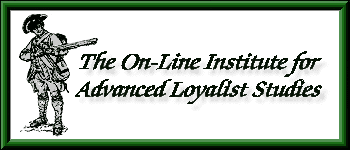

|
 |
|
The history of the King's American Regiment is presented in 8 parts. Click below to skip to:
Part 1 - Introduction & Recruiting a Regiment, |
History of the King's American Regiment - Part 8 of 8 |
|
Into History 1782/1783 Upon the evacuation of Savannah, a large detachment of the regiment was sent to New York, but the bulk was transported to Charlestown to sit and do duty while awaiting the fate of America at a conference table in Europe. There was the occasional skirmish, but offensive operations had been halted. The most significant occurrence at Charlestown was receiving word that Major GRANT had died on board the transport taking the detachment from Savannah to New York. This vacancy led the way for Brevet Major John COFFIN of the New York Volunteers to be commissioned major in the KAR as of 20 September 1782. COFFIN had led a marvelous career through Georgia and South Carolina between 1779–1782, particularly with the light infantry and cavalry. With the evacuation of Charlestown in December, the regiment was reunited as a whole in New York in January of 1783. It was time for personal scores to be settled. While the end of the war and the independence of the Americans was rapidly approaching, there was some reason for pride in the KAR. In March of 1781 they had been placed on what was known as the American Establishment as the 4th American Regiment.85 This guaranteed their officers half pay at the end of hostilities, confirmed their rank in British North America, and allowed the unit to purchase distinctive clothing directly from England. At the end of the war this uniform was red faced blue, with gold lace for the officers and buttons marked with the number "4." On top of this distinction, the regiment was elevated to the British Establishment on 25 December 1782, in effect making them a regular British regiment. The ranks of the officers would now be permanent anywhere in the British Empire.86 Despite this good news, the end of hostilities allowed old grudges that had been brewing to surface within the regiment. Captain DePEYSTER was once again put under arrest by Lt. Col. CAMPBELL, charged with inciting mutiny within the regiment, disobedience of orders, neglect of duty and a host of other charges. He was acquitted of all charges.87 It was now CAMPBELL's turn to be accused and tried. Virtually every one of the officers under his command stepped forward and detailed the tension in the regiment and the terrible fatigues it had undergone, and how Lt. Col. CAMPBELL had contributed negatively to everything. The court agreed. They found him guilty of falsely accusing Captain DePEYSTER, not accounting for large sums of the regiment's money and acting in a tyrannical and oppressive manner. For all of this, he was sentenced to be suspended without pay for six months.88 But the tension was not over. Major COFFIN had not served long in the regiment, but what he had seen and experienced led him to an instant dislike of CAMPBELL. After the sentence of the court a "fracas" occurred in the street between the two officers, which led COFFIN to challenge CAMPBELL to a duel, which the latter refused. COFFIN then took to "posting" CAMPBELL in public places; that is to say, he wrote extremely inflammatory pieces about him and put them up in public places to draw CAMPBELL into a duel. This worked insofar as to have the two of them exchange two shots each with pistols. Neither of them were hit. On the morning of 19 July 1783 they once again met. Each fired two shots at the other at a distance of five yards. COFFIN's shots grazed CAMPBELL in the thigh and knocked a button off his coat. "Damn'd good shots" was how one spectator described them. CAMPBELL's shot struck COFFIN in the groin, instantly ending the duel but thankfully not COFFIN's life. And so honor was satisfied...89 And in a rather inglorious manner, the service of a much distinguished regiment ended. America was independent and the British would evacuate New York. They would keep to their word of providing land grants to the soldiers, as well as to civilian refugees. The fleets would sail to Nova Scotia in early September of 1783, arriving a few weeks later in the River Saint John. The regiment was officially disbanded on 10 October 1783, thus concluding the history of one of many gallant regiments of the American Revolution.
85 Germain to Clinton, 7 March 1781. Papers of the Continental Congress, M247, r65, I51, V. 1, Pages 805–808.
Click here for ---> Regimental History Main Page More King's American Regiment History KAR History:
The On-Line Institute for Advanced Loyalist Studies
|